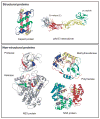Structural proteomics of dengue virus
- PMID: 18644250
- PMCID: PMC2581888
- DOI: 10.1016/j.mib.2008.06.004
Structural proteomics of dengue virus
Abstract
In this paper, we discuss recent advances in our knowledge of the dengue virus life cycle based on new structural data of the virus and its proteins. Specifically, we focus on the structure of the pre-membrane protein, prM and its role in virus assembly, the first full-length structure of a multi-domain dengue virus replication protein, NS3, and the recently solved structures of NS5 methyltransferase and polymerase domains. These structures provide a basis for describing function and predicting putative host interactions.
Figures



References
-
- Morens DM, Fauci AS. Dengue and hemorrhagic fever: a potential threat to public health in the United States. Jama. 2008;299:214–216. - PubMed
-
- Gould EA, Solomon T. Pathogenic flaviviruses. Lancet. 2008;371:500–509. - PubMed
-
- Kuhn RJ. The Flaviviruses. In: Acheson NH, editor. Fundamentals of Molecular Virology. 2004. in press.
Publication types
MeSH terms
Substances
Grants and funding
LinkOut - more resources
Full Text Sources
Other Literature Sources
Research Materials

